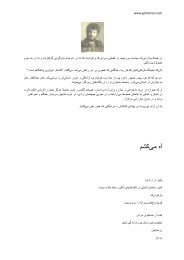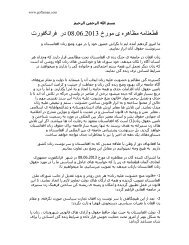Power-Sharing - Goftaman.com
Power-Sharing - Goftaman.com
Power-Sharing - Goftaman.com
- No tags were found...
You also want an ePaper? Increase the reach of your titles
YUMPU automatically turns print PDFs into web optimized ePapers that Google loves.
SECURITYThere are two international military <strong>com</strong>mands in Afghanistan: the U.S.-led Coalitionand the North Atlantic Treaty Organization (NATO)–led International SecurityAssistance Force (ISAF). The Coalition, whose primary mission is defined ascounterterrorism and counterinsurgency, and which enjoys freedom of action under theUnited States’ right of self defense, came to Afghanistan to assure first the security ofAmericans from al-Qaeda and then of the Afghan government from the insurgency. 4ISAF’s mission is to help the Afghan authorities provide security according to the BonnAgreement, relevant UN Security Council resolutions, and a bilateral agreement with theAfghan government.The avowed goal of both <strong>com</strong>mands is to provide security directly until Afghansecurity forces are prepared to do so themselves. Building Afghan national capacity toprovide security requires the policies known as security sector reform (SSR), includingboth the dissolution of irregular armed groups through demobilization, disarmament, andreintegration (DDR), and the creation or transformation of previous forces intoprofessional units.Both the Coalition and ISAF have operated with a light footprint that has beeninadequate to deliver security. 5 Achieving this goal has also been hampered by lack ofcoordination between the two <strong>com</strong>mands’ different definitions of security priorities. TheCoalition armed and funded Afghan <strong>com</strong>manders to seize and hold ground after theTaliban and al-Qaeda fled the U.S. air offensive. Some of these <strong>com</strong>manders used themoney and arms they received to invest in drug production and engage in land grabs,predation, political intimidation, and ethnic cleansing––a major source of insecurity for4 The United States began building a “coalition of the willing” against terrorism on September 12, 2001;there are currently seventy nations supporting the global war on terrorism. To date, twenty-one nationshave deployed more than 16,000 troops to the U.S. Central Command’s region of responsibility. InAfghanistan, Coalition partners are contributing approximately 8,000 troops to Operation EnduringFreedom and to the ISAF in Kabul. See http://www.cent<strong>com</strong>.mil/sites/uscent<strong>com</strong>1/Shared%20Documents/Coalition.aspx.5 Michael Bhatia et al., “Minimal Investments, Minimal Results: The Failure of Security Policy inAfghanistan,” Afghanistan Research and Evaluation Unit, June 2004; James Dobbins et al., America’s Rolein Nation-Building: From Germany to Iraq (Santa Monica: RAND, 2003); Seth G. Jones, “Averting Failurein Afghanistan,” Survival, Vol. 48, No. 1 (Spring 2006).5
















